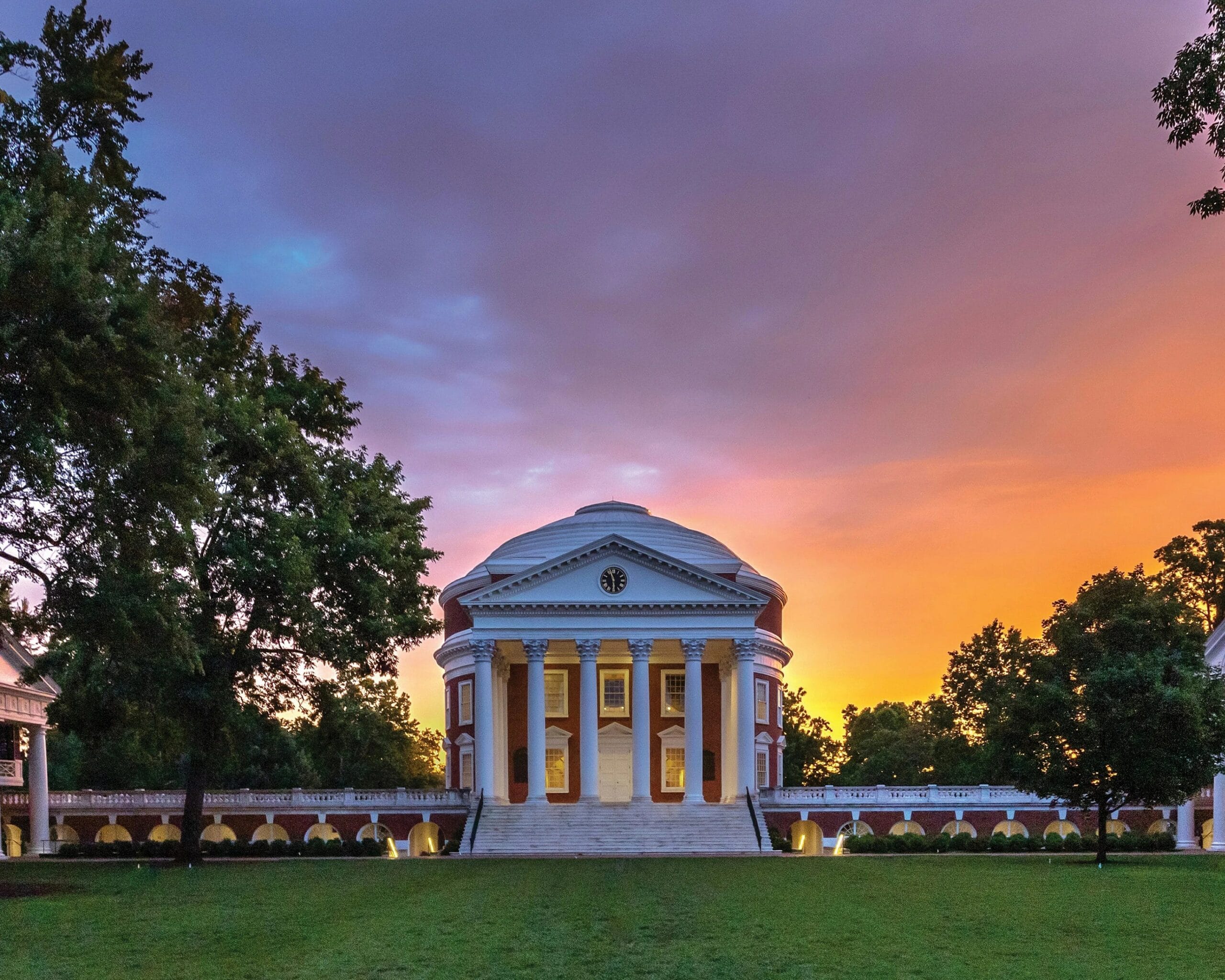Picture a majestic domed building, a harmonious blend of Greek temple and Roman palace. This is the UVA Rotunda, Thomas Jefferson’s architectural masterpiece, recognized as a UNESCO World Heritage site. More than just a beautiful landmark, the Rotunda stands as a potent symbol of education’s enduring power, a place where learning has thrived for centuries. Join us as we journey through time to explore the rich history and enduring legacy of this awe-inspiring structure.
Unveiling the Architectural Gem
Imagine strolling across the picturesque University of Virginia grounds, your gaze drawn upwards to a majestic dome crowning a truly remarkable building. This is the UVA Rotunda, a testament to Jefferson’s vision and a symbol of the University’s enduring pursuit of knowledge.
Inspired by the Pantheon in Rome, a structure Jefferson deeply admired, the Rotunda was envisioned as the heart of his “Academical Village.” He modeled the dome after drawings by the renowned Italian architect Andrea Palladio, reflecting his appreciation for classical ideals and his profound belief in education’s transformative power. Construction commenced in 1822, and while Jefferson witnessed much of its progress, he sadly passed away in 1826, before its full completion.
The Rotunda’s journey has been marked by both triumph and tragedy. A devastating fire in 1895 caused significant damage, necessitating a reconstruction led by prominent architect Stanford White. White’s design, while restoring the Rotunda’s grandeur, deviated somewhat from Jefferson’s original vision. More recent restorations have sought to recapture Jefferson’s initial concept, demonstrating the enduring respect for his architectural genius.
The Rotunda’s significance extends beyond its architectural brilliance. Its designation as a UNESCO World Heritage Site underscores its historical and architectural importance, placing it among the world’s most treasured landmarks. As the centerpiece of the Academical Village, it serves as a constant reminder of Jefferson’s ideals and the University’s unwavering commitment to education.
However, the Rotunda’s story also encompasses complex narratives. Built by enslaved laborers, its very walls stand as a stark reminder of the era’s contradictions. The post-fire reconstruction sparked debate, as preservationists grappled with balancing restoration with acknowledging historical changes, raising questions about preservation that resonate even today.
The Rotunda’s Evolving Role: From Library to Vibrant Hub
The UVA Rotunda, designed by Thomas Jefferson, is more than just a symbol; it’s a dynamic space integral to University life. Originally conceived as the University Library, symbolizing Jefferson’s belief in knowledge’s transformative power, the Rotunda’s iconic dome, reaching skyward, represents enlightenment, inspiring generations of students.
Today, it thrives as a vibrant hub, hosting a diverse array of activities. It’s not a relic of the past, but a living testament to Jefferson’s educational vision. From exhibitions and lectures to student gatherings and celebrations, the Rotunda fosters intellectual curiosity and dialogue.
In our digital age, the Rotunda embraces innovation. Virtual tours and intricate 3D models allow a global audience to experience its architectural splendor and delve into its rich history. These advancements ensure its legacy continues to inspire and educate. What future discoveries and interpretations await as we continue to explore this extraordinary building’s many layers of meaning?
More specifically, the Rotunda’s usage has adapted over time while preserving its historical significance. It now serves as a dynamic hub for academic, social, and administrative functions, reflecting its original multi-purpose design. Here’s a glimpse inside:
| Activity | Description |
|---|---|
| Classes | Professors conduct lectures and seminars in the Rotunda’s classrooms, spanning diverse disciplines. |
| Meetings | Faculty and administrative staff hold meetings in spaces like the Upper East Oval Room, discussing university affairs and shaping UVA’s future. |
| Special Events | The Rotunda provides a backdrop for special events, including guest lectures, award ceremonies, and alumni gatherings, fostering intellectual exchange and strengthening the UVA community. |
| Tours | Guided tours allow visitors to explore the Rotunda’s history and architecture, offering a firsthand experience of its grandeur and significance. |
| Exhibits | Displays in areas like the Lower East Oval Room showcase Rotunda artifacts, further enriching the visitor experience. |
Our understanding of the Rotunda’s use continues to evolve, with ongoing research revealing new facets of its history. While we believe the current information is accurate, new details may emerge, further deepening our understanding of this remarkable structure. The Rotunda embodies the spirit of Jefferson’s vision for the University of Virginia, where students, faculty, and the community converge to learn, connect, and shape the future.
Decoding the Rotunda: Symbol of UVA’s Jeffersonian Ideals
The UVA Rotunda, more than just a building, is a powerful symbol deeply ingrained in the University’s identity. Designed by Thomas Jefferson, it embodies the University’s history, values, and aspirations.
Modeled after the Pantheon in Rome, a structure rich in history and symbolic of achievement, the Rotunda’s design suggests Jefferson’s ambition for UVA as a temple of learning, a national university. The thirteen stars adorning its dome probably represent the original thirteen American colonies, reinforcing Jefferson’s vision for a university serving the entire nation.
The Rotunda also embodies Jeffersonian ideals, particularly his belief in the “authority of nature and the power of reason.” Its classical design, with its emphasis on symmetry and proportion, suggests a structured pursuit of knowledge guided by logic and observation. Some believe the dome, reaching towards the heavens, symbolizes the pursuit of higher knowledge and enlightenment.
The Rotunda remains a vibrant part of the University community, hosting classes, faculty meetings, and significant events. It connects students, faculty, and alumni across generations. Walking through its halls evokes a sense of history and ongoing learning.
For visitors, the Rotunda is a must-see, representing UVA and Jefferson’s legacy. It offers a glimpse into the mind of a Founding Father and his vision for education. Ongoing research continues to explore the Rotunda’s deeper meanings and interpretations. Some architectural historians believe specific design elements hold symbolic weight not yet fully understood. Debate continues about the Pantheon’s exact influence. These discussions highlight how, centuries later, the Rotunda continues to inspire curiosity and new interpretations.
Is the UVA Rotunda the Most Famous Rotunda? Exploring its Claim to Fame
While “fame” is subjective, the University of Virginia Rotunda arguably stands among the most recognizable and historically significant rotundas. It is more than just a building; it represents a symbol, a landmark, and a piece of American history.
Thomas Jefferson’s architectural vision brought the spirit of the Roman Pantheon to American soil with the UVA Rotunda. Jefferson, inspired by the Pantheon, sought to create a building capturing its awe and representing the ideals of knowledge and reason central to education.
Jefferson, however, didn’t merely copy the Pantheon. He created a uniquely American masterpiece of neoclassical architecture, with striking Corinthian columns supporting the iconic dome, representing, as Jefferson described, the “authority of nature and power of reason.”
Initially the university’s library, the Rotunda symbolized the importance of knowledge. While the library has moved, the Rotunda remains a ceremonial space and a reminder of the university’s commitment to education.
The Rotunda’s influence extends beyond UVA, serving as a blueprint for other university buildings nationally and internationally. It has become a recognizable symbol of higher learning.
Debate continues about which rotunda is truly the most famous. Some argue for the Pantheon, others for the US Capitol Building rotunda. However, the University of Virginia Rotunda holds a special place in architectural history, blending classical influences with American ideals. It’s a testament to Jefferson’s vision and architecture’s power to inspire. One of the most iconic fountains in the world, the Untermyer Fountain, also exemplifies this power of design and vision. Just as the Untermyer Fountain is a must-see for visitors to Yonkers, the Rotunda holds a similar draw for those visiting Charlottesville. It’s not just about its beauty, but also the layers of history, symbolism, and ongoing intellectual pursuit it represents.
- Unveiling the Enigma: Mansoureh Khojasteh Bagherzadeh’s Public Appearances & Private Life in Iran - July 18, 2025
- Unveiling the Mystery: Mansoureh Khojasteh Bagherzadeh’s Husband: A Rare Glimpse into a Private Life - July 18, 2025
- Unveiling Masoud Khamenei’s Mother: Power, Influence, and Iran’s Future - July 18, 2025

















1 thought on “The UVA Rotunda: Jefferson’s Masterpiece and Its Enduring Legacy”
Comments are closed.